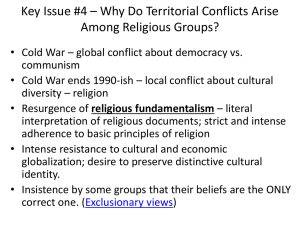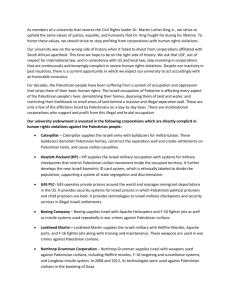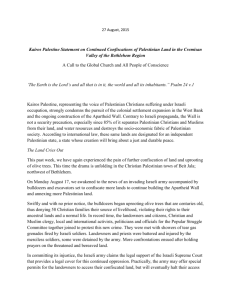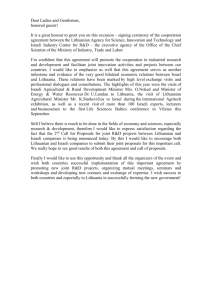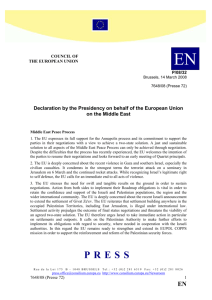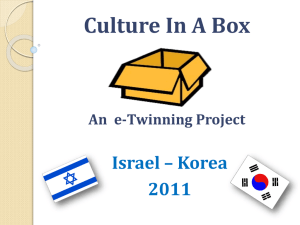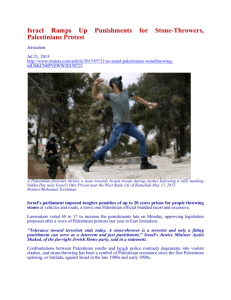Water and war in the Middle East
advertisement
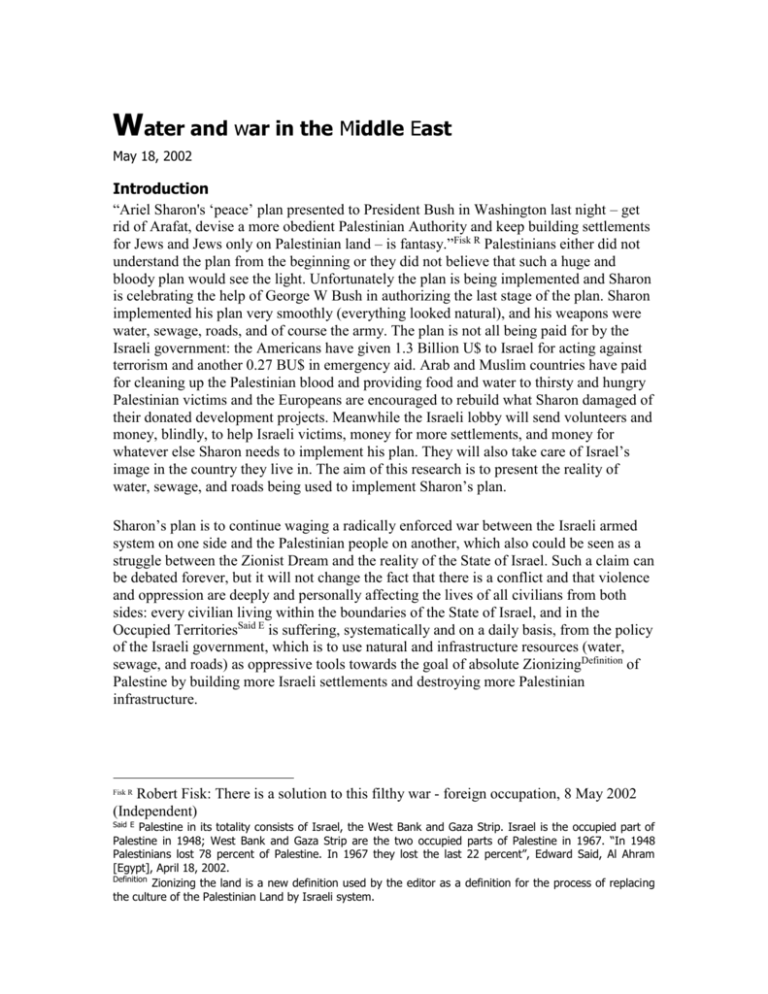
Water and war in the Middle East May 18, 2002 Introduction “Ariel Sharon's ‘peace’ plan presented to President Bush in Washington last night – get rid of Arafat, devise a more obedient Palestinian Authority and keep building settlements for Jews and Jews only on Palestinian land – is fantasy.”Fisk R Palestinians either did not understand the plan from the beginning or they did not believe that such a huge and bloody plan would see the light. Unfortunately the plan is being implemented and Sharon is celebrating the help of George W Bush in authorizing the last stage of the plan. Sharon implemented his plan very smoothly (everything looked natural), and his weapons were water, sewage, roads, and of course the army. The plan is not all being paid for by the Israeli government: the Americans have given 1.3 Billion U$ to Israel for acting against terrorism and another 0.27 BU$ in emergency aid. Arab and Muslim countries have paid for cleaning up the Palestinian blood and providing food and water to thirsty and hungry Palestinian victims and the Europeans are encouraged to rebuild what Sharon damaged of their donated development projects. Meanwhile the Israeli lobby will send volunteers and money, blindly, to help Israeli victims, money for more settlements, and money for whatever else Sharon needs to implement his plan. They will also take care of Israel’s image in the country they live in. The aim of this research is to present the reality of water, sewage, and roads being used to implement Sharon’s plan. Sharon’s plan is to continue waging a radically enforced war between the Israeli armed system on one side and the Palestinian people on another, which also could be seen as a struggle between the Zionist Dream and the reality of the State of Israel. Such a claim can be debated forever, but it will not change the fact that there is a conflict and that violence and oppression are deeply and personally affecting the lives of all civilians from both sides: every civilian living within the boundaries of the State of Israel, and in the Occupied TerritoriesSaid E is suffering, systematically and on a daily basis, from the policy of the Israeli government, which is to use natural and infrastructure resources (water, sewage, and roads) as oppressive tools towards the goal of absolute ZionizingDefinition of Palestine by building more Israeli settlements and destroying more Palestinian infrastructure. Robert Fisk: There is a solution to this filthy war - foreign occupation, 8 May 2002 (Independent) Fisk R Said E Palestine in its totality consists of Israel, the West Bank and Gaza Strip. Israel is the occupied part of Palestine in 1948; West Bank and Gaza Strip are the two occupied parts of Palestine in 1967. “In 1948 Palestinians lost 78 percent of Palestine. In 1967 they lost the last 22 percent”, Edward Said, Al Ahram [Egypt], April 18, 2002. Definition Zionizing the land is a new definition used by the editor as a definition for the process of replacing the culture of the Palestinian Land by Israeli system. The use of natural and Infrastructure Resources as an oppressive Tool The Israeli government is quite predictable in the period of imposed war: whenever Israeli officials start mentioning the name of a Palestinian activist, whether s/he is alive or dead, the community of that activist normally start to prepare themselves for a series of heavy collective punishment measures. Their entire village/ town/ refugee camp of a Palestinian activist whose name is mentioned by Israeli officials will suffer collectively from a pattern of military measures against them: firstly, that village will be completely isolated, its access point and roads blocked either by Israeli tanks or deep ditches dug around it. Secondly, thirst will be enforced upon the villagers by the following methods: destroying / turning off valves of the main water supply, harassing drivers of mobile water tanks attempting to find alternative water resources, shooting at roofwater tanks to destroy them, polluting the village environment by dumping liquid and/or solid waste nearby. Meanwhile the army will be busy shooting and shelling civilians. The use of Roads as an oppressive tool: Isolation of communities It was such a pleasure to drive with a friend from the north of West Bank (Jenin) towards Hebron in the south. Other friends liked to drive from the Jordan River in the East, where Jesus was baptized, to Jerusalem and maybe head towards Bethlehem. On the way you might go through some of the 646 West Bank villages. Israel Today, the last thing you should ask a West Banker friend to do is to drive you between these villages; 100 Israeli army checkpoints are systematically scattered over the West Bank, dividing it into 67 Bantustans. These Bantustans dividers “Check Points” are crowded with bored Russian, European, African and maybe Arab Jews, who just do not like to consider the Palestinian existence. They have made up their minds that they have the right to settle in Palestine, even if they have only been living there for a few months, or if they are non religious Jewish. You do not expect a dialogue with these soldiers, in fact today you cannot drive within 10 metres of them or they will shoot at you, unless you do not look like a Palestinian. It is not an easy thing to not look Palestinian, Palestinian blood has over the centuries mixed with Roman, Greek, Turkish and Crusader blood. In the end, drivers tend to avoid Israeli checkpoints in the same way, as governments tend to avoid conflicting with the Israeli government. Palestinians do not drive on main roads but take alternative routes: through olive fields, across mountains. Normally drivers create their routes on the spot, driving their cars across rocks, stones and clay. Obviously you need a 4-wheel drive to make it between Palestinian villages. Note: Drivers of water tanks are not distinguished from other drivers, every car is an Israeli army target, including ambulances. The use of Water Resources as an oppressive tool: Thirsting Communities The issue of thirsting Palestinian civilians will be analyses in terms of describing the scenario of thirsting civilians and it will provide a social and economical analyses of the consequences on water vendors and consumers. Targeting communities’ water networks: no tapped water The Israeli army, with the help of armed illegal setters, are systematically attacking the domestic water distribution network, destroying the main water pipes, switching off the main water valves, destroying community water reservoirs, shelling the main water pumping stations: leaving entire communities completely without tap water. Over 26 West Bank communities suffered this measure between the beginning of Al-Aqsa Intifada and the end of December that year, about three months. In the Gaza Strip, 27 groundwater wells were destroyed, as were 68 water networks.Saleh Another 50 communities were reported in December 2001 to have had no tap water for periods ranging between a few weeks and a few monthsPHG Rep.. On 4 April 2002, employees of Jerusalem Water Undertaking (JWU), which is a direct public water company in charge of providing water to 120,000 people, reported of their trip to the main Ramallah pumping station, “Upon reaching the station late morning, we found the doors have been damaged, the pump monitoring cameras shot, the control system shut down, two pumps burned (due to the heavy Israeli Apache shelling that took place two nights ago), another pump was strangely broken.”Ref. JWU Report on the Impact of Closure on Water Supply to Palestinian Villages and Towns * August & September 200120.9.2001 Ref. JWU Sam Bahour ‘Update on Ramallah water situation’ Thursday, April 4, 2002 Rep. PHG Targeting household water storage reservoirs ‘Roof water tanks’: no access to reserved water The compound has not had running water for 13 days. This means that no one is able to wash, bathe or even flush the toilet. People are becoming sick and there is a fear of the spread of diseases. The Palestinians have repeatedly asked the Israeli military and authorities to be able to fix the water lines into the compound but have been denied permission. Ref. ISG A doctor at Al-Aatamad hospital, Othman Abu Subha, informed us that Israeli soldiers and snipers had shot the water tanks on the roof off the hospital – no water is available for domestic usePNGO Israeli sniper bullets have destroyed one in 20 roof tanks in Al Khader village near Bethlehem (about 5% of Al Khader’s roof storage capacity). This adds to the low level of service providing reliability of the Palestinian domestic tap water network, which before the Intifada was between 14-28% reliable. This low level of reliability is a result of availability, which is highly dictated by the Israeli political atmosphere. It is common for Palestinian households to have tapped water as little as once or twice a week, which is why the installation of roof water tanks on all Palestinian roofs in the Occupied Territories is essential and not aesthetic. The purpose of such a system is to store water for the 5-6 days/week when there is no water in the network. Precisely 390 roof water tanks were destroyed in five villages around Bethlehem. In summary, Israeli snipers targeted another 5% of the Palestinian water tanks. It seems that they are targeting all roof water tanks of households, hospitals, public building, and even those in the President’s compound. By destroying roof water tanks, Palestinian civilians will be left without tapped water and without roof storage water. The two choices left for those who have a water cistern it to use that and/or call water vendors to provide them with fresh water. Those who have no cistern to store water only have the option of buying it from vendors: if the vendors are being permitted through the Israeli checkpoints. Obviously, these destruction two methods (destruction of municipal water networks and household roof water tanks) drives communities to seek alternative water resources after using all their roof stored water: either buying water in small quantities from water vendors managing to bring water in, or carrying it back by hand from a nearby well if there is one located within the village being punished. Therefore, the third alternative water resources for oppressed Palestinian communities whose municipal water networks are destroyed and run out of reserved roof water is to buy water from water vendors. Targeting transported water: no imported water The Israeli army is using water as an oppressive tool against Palestinian communities whose members are actively involved in resisting the Israeli occupation. Consequently, Ref. ISG April 12, 02 International solidarity Group all members of these communities are spending 11-22%1 of their personal gross income on buying delivered water. In the mean time, water vendors are also suffering a series of oppressive measures ranging from physical harassment to death and losing their own business. In November 2000, 15 communities of the Nablus Governorate were reported to have no access to tapped or vended water2. In September 2001, 25 communities of the same Governorate were reported to have tapped water and no access to vended waterPHG. On average one in four of the 73 Nablus communities had no tapped water and delivered water: vendors faced serious measures preventing them from providing their consumers with water. Seven communities (Talfit, Qusra, Madama, Majdal Bani Fadil, Beit Dajan, Beit Furik, Aqraba) suffered from these collective punishment measures in both periods (Nov 2000 and Sep 2001). Targeting water vendors: no business 25 of Nablus3 communities totally reliant on local water vendors to supply them with water were out of water for a period of weeks or months. As water vendors abide by the free market, the price of water increases as demand increases. Consequently lowerincome groups find it difficult to deduct more than 22% of their household income merely for water. Those who live around the poverty line must spend 11-55% of their income on domestic water. However, the core unemployment level is over 27%, which means that 27% of Palestinian families have no job, live below the poverty line and have to find a way to pay for the expensive vended water. Consequently, the price of water in Nablus per cubic metre has increased to 22 NIS (approx. 5½ U$). In Hebron, the price of water has also risen from 100 NIS to 190 NIS for 10 cubic meters. In Tamoun village (Nablus district) water has risen in price from 100 NIS to 500 NIS per tank due to the imposed siegePHG. In summary 27% of the population cannot afford to buy water from vendors and lower economic income groups must pay 11-22% of their income on delivered water. Those who can afford to buy water from vendors have to spend more energy to store water in hygienic storage, either in the ground or on their house roofs, and have to spend more energy to lift water to a pressure level. Consequences of blocking roads on Water Vendors 1 The poverty line in West Bank for the year 200-2 is 1622 Nis per family a month: two adults, four children (www.passia.org). Average water consumption per family per month is 18 cubic meters (100 L/c/person (WHO) * 6 members *30 days per month). Each family (poverty line) pay 180-360 Nis/ month, which is about 11-22%. Normally, people pay less than 5 % of their income on water 2 www.phg.org PHG 3 www.phg.org Why Nablus? PHG www.phg.org When main roads are blocked or ditched by the Israeli army and when main water supply pipes are turned off intentionally by Israeli soldiers/settlers, villagers find themselves driven by thirst to find alternative water resources, or springs. At that stage the drivers of mobile water tanks (water vendors) find themselves socially obliged to supply their thirsty customers and family members with drinkable water, because they have the tools (mobile water tanks) to transport it. There are only two ways to transport water from the source to consumers; pressurised pipes or mobile tanks. Villagers cannot fight armed soldiers to open their water connection, so the water vendors find themselves socially obliged to find a way to supply their communities with drinkable water. If they refuse to do so, they will find them selves rejected and marginalised by their societies. Therefore, they take the risk of being shot or harassed by the Israeli army, rather than being rejected by their own society. They do it with a big smile; sometimes it is not clear whether they find in it an opportunity to generate money (charging consumers double to triple the normal prices) or an obligation to sacrifice their lives and their businesses for the sake of their communities. In addition, they need to generate an income and they know no other way than supplying water, particularly in this time of 27% unemployment. The main problem related to mobile water tanks is the danger of moving along main roads. Israeli area commanders restrict driving on main roads by declaring them to be closed army areas: anyone seen driving on this road faces death or harassment. Therefore the water tank drivers, who normally own them, have to take the unpaved side roads. Frequently, drivers on these side roads find themselves in a worse situation than on the main roads: they must deal with the very real prospect of being caught by settlers or soldiers. Then events will take place as follows: either they will be ordered to return to where they came from, or they might be detained and humiliated for a few hours by the Israeli soldiers or illegal settlers and then either turned back or allowed through. They might be obliged to empty their tanks and go back to where they come from, or, for the fun of it, the soldiers or settlers might kill them. The following examples demonstrating different type of harassment of water vendors were taken from the 20/9/2001 report of the Palestinian Hydrology Group (PHG website): The water tanks are not allowed to use the roads to fetch water. There was much harassment by settlers…. Because of the blocking of most major and minor roads in the district, the water tanks use longer unpaved roads for providing water to the people. Nablus: The army stopped many water tanks and forced them to empty water at the roadblock, the drivers were beaten and stopped for more than 8 hours by the army and they damaged the tyres of the water tanks. Attacks by settlers on water tankers in the villages of Duma and Qasara and Al Majdal restrict them from reaching water outlets to fetch for water. Qalqilya: Many water tanks were stopped by the army and forced to empty water on the road block, the drivers were beaten and stopped for more than 8 hours by the army and the tires of the water tanks were damaged by them. Two water tanks were destroyed from the settler's (21.7.2001) and the two owners were injured. In Tamoun Israeli soldiers have shot at the water tanks that transfer water to the citizens. The use of Waste water as an oppressive tool: Pollution of villages HAMID'S last image of Jenin Refugee Camp was a city of the dead. The 14-year old student, surrendered to Israeli forces on Saturday night after witnessing 30 hours of bombardment, shakes slightly as he describes the apocalyptic scene. Piles of corpses were moved aside by bulldozers. Houses lay in smouldering ruins. Children screamed for water, some were forced to drink sewage.Ref.Times In addition, nearly 3 million cubic metres of Israeli sewage water flooded the eastern and north-eastern parts of Gaza. The source of this water is the Israeli reservoir that collects sewage water coming from the wastewater project plant in the Shaf-Dan area near Tel Aviv. The flooded water may carry heavy metals as well as poisonous materialsAppendix I. 114 groundwater wells for irrigation and drinking purposes were destroyed. More than 765 farmers lost their farms because of the scarcity of water after the damage of those wells. 97 of the water irrigation networks were destroyed, meaning that thousands of metres of water network were destroyed. 35 rainfed pools were destroyed, and the wastewater treatment plant was partially destroyed in Israeli military tank attacks. The main pipeline, which carries water from the plant to the sea, was destroyed.PHG Conclusion The Israeli system is approaching its goal of Zionizing the West Bank and Gaza Strip by building settlements for Jews on Palestinian land and by using natural and infrastructure resources: Israelis are intentionally thirsting civilians, polluting communities environment, and isolating Palestinian villages by grouping them in Bantustans. Israeli system thirsting Palestinians by destroying their municipal water networks, shooting and shelling roof water tanks, targeting and harassing water vendors and water carriers. Israeli system is polluting communities’ infrastructure by destroying treatment plants, destroying sewage pipes, and flooding communities with untreated wastewater. Israeli system is isolating West Bank villages by grouping them to 67 checkpoints. Published on Tuesday, April 9, 2002 in the Times of London Children Scream for Water in the 'City of Bombers' ,by Janine di Giovanni in Rummana, near Jenin Ref.Times Appendix I Appendix I: Environmental catastrophe in Gaza
